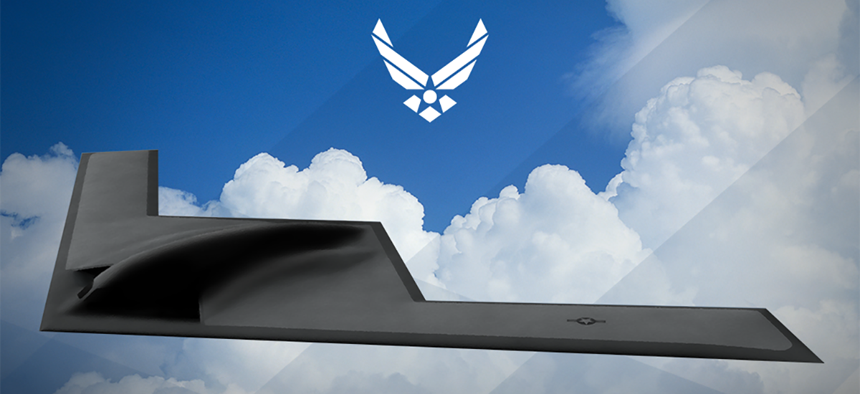Keep It Secret: Congress Should Back Off the B-21 Program
Lawmakers' calls for more transparency and fixed-price contracts will only hurt an Air Force acquisition effort that is doing well so far.
Five times in April, Russian military forces flexed their muscles against American military personnel out on patrol, repeatedly conducting dangerous barrel rolls over an Air Force recon aircraft and buzzing a U.S. Navy destroyer on patrol in the Baltic. Yet instead of helping to craft a response to these uncontested provocations, Congress is threatening to upend the Air Force’s crucial bomber program just as it takes off after a decade of failed launches.
As Congress debates its annual 2,000-page defense authorization bills this month, one issue in particular will likely go all the way to a formal White House veto threat. That disagreement is the Senate’s push for the Air Force to publicly disclose its cost estimate for its new B-21 bomber. For operational secrecy, the Air Force legitimately refuses to reveal how far under the original cost estimate the development phase currently is — hardly your typical “defense acquisition gone wild” headline.
But this is not a simple accounting or transparency dispute. Congress wants the Air Force to give away the “crown jewels” of a necessarily secretive program. The past two decades saw continued breaches of major American weapons programs—think the C-17 airlifter and F-35 fighter—by the Chinese and others. This theft of state secrets allows adversaries to plan and build cheaper, faster counters to U.S. technology. The openness and insecurity of the Pentagon’s acquisition system contributes directly to the rapid erosion of the U.S. military’s technological edge.
Worse, unneeded transparency risks sacrificing a national military advantage for no tangible gain. Because weight and cost are so closely correlated for aircraft development, revealing the final cost estimate could allow adversaries to piece together a useful sketch of the bomber’s range, payload, and most importantly for stealthy aircraft, its size. Additionally, the B-21’s secrecy so far helped it avoid the “requirements creep” and gold-plating that could initiate the program’s spiral into failure, as happened with the DDG-1000 Zumwalt destroyer and Expeditionary Fighting Vehicle.
The reality is that Congress has successfully overseen highly classified programs for decades and could ably do so for the B-21 bomber. While public disclosure is often conducive to oversight, it can hamper certain weapons programs, encouraging political tampering that engenders cost overruns, schedule delays, and over-sharing of critical technical details.
Related: Here Are A Few Things the New Air Force Bomber Will Do Besides Drop Bombs
Read more: New Air Force Bomber Is a Critical Piece of the Pentagon’s Pacific Weaponry
See also: Meet the Secretive Team Shaping the Air Force’s New Bomber
If public debate on the bomber’s cost is necessary, will Congress treat classified Navy and Army programs similarly? Unlikely, given that the Air Force’s bomber replacement has always fought for every scrap of support both in the Pentagon and on Capitol Hill. After numerous misfires and cancellations since 2005, America’s airmen can finally point to a promising, cost-effective program in the B-21. The program is poised to beat both its development and production cost targets and finally meet the Air Force’s demonstrable and growing need for a large fleet of kick-down-the-door penetrating bombers.
A second challenge from the Senate Armed Services Committee is likely to venture deeper beyond award cost into contract type. Chairman Sen. John McCain, R-Ariz., believes the Air Force used the wrong contract for the program’s development. The “cost-plus” contract currently in place pays the contractor as it performs work. These contracts are often used for the risky development phase when a cost estimate is very difficult to get right. By contrast, McCain wants the Air Force to use a “fixed-price” contract where the Air Force and the contractor set a price and any cost increase above that comes from the company’s coffers.
Left unsaid is that the Air Force has already indicated that the entire production phase of the bomber program—70 percent or more of its total cost—will be conducted on a fixed-price basis.
Fixed-price contracts work well for the production of low-complexity aircraft and vehicles with large commercial and foreign sales prospects. Yet misapplied fixed-price aircraft development programs have encountered great difficulty—for example, the F-111, V-22, C-5, C-17, and A-12 aircraft programs.
While critics of the Air Force cite the success of a fixed-price contract in making Boeing pay for development overruns on the new KC-46A aerial tanker, this argument elides the fact that the bomber is far more complex than the tanker and Boeing was willing to sign any contract, no matter how harsh, to keep Airbus out of the American tanker market.
Even as this high-risk, low-reward argument goes on, Congress continues to ignore real egregious contracting mishaps such as the “lowest price, technically acceptable” solicitation for a $17.5 billion IT contract.
In short, for a promise of small cost savings unlikely to materialize, backseat driving on the B-21 contract will certainly further delay the program and quite possibly lead to the same cost overruns Congress wants to avoid.
The B-21 bomber has already suffered six months of “process” delay resulting from a failed Lockheed/Boeing bid protest in late 2015. The U.S. Air Force—and more importantly the entire joint force—cannot afford further delays in fielding this foundational capability for 21st-century power projection.
The Air Force’s new bomber is a necessary American strategic asset and essential investment. We risk sacrificing deterrence and actually losing in war without the B-21.





